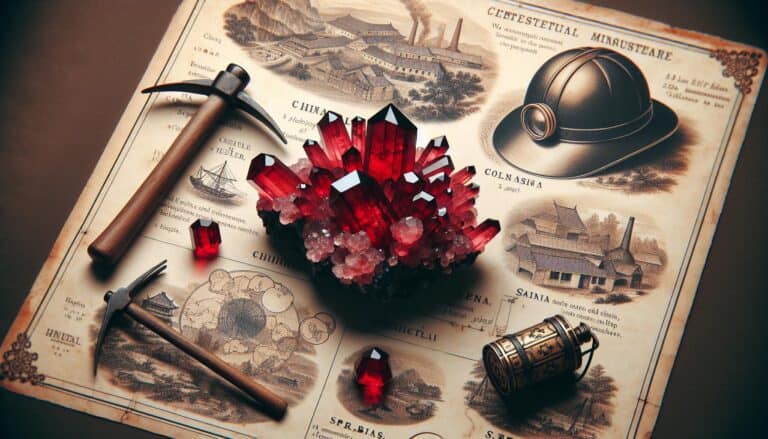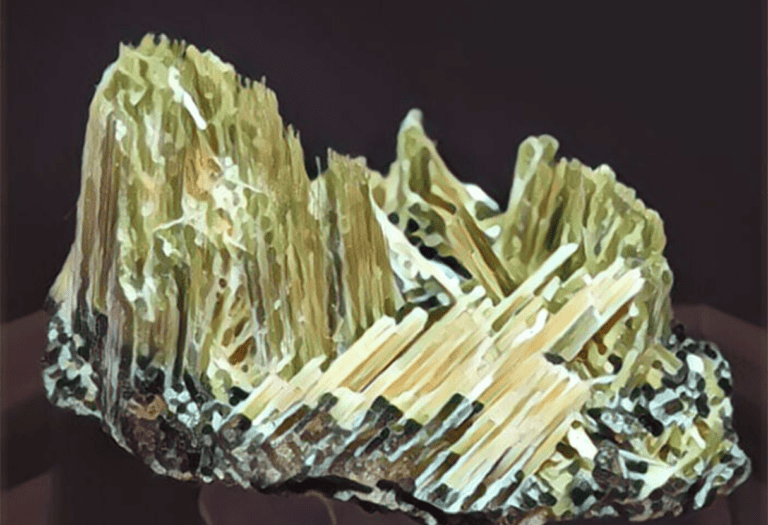Scapolite, a gemstone that’s as unique as it is mysterious, might’ve caught your eye with its range of colors and impressive metaphysical properties.
You’re probably curious about how to distinguish this rare gem from its more common counterparts.
Knowing how to identify scapolite is crucial, whether you’re a collector, a jeweler, or just someone with an appreciation for stunning minerals.
Let’s dive into the key characteristics that set scapolite apart, ensuring you can spot the real deal with confidence.
To identify scapolite, check for long prismatic crystals, typically white, gray, or purple. Conduct a streak test (white streak), and a magnet test (non-magnetic). Scapolite’s Mohs hardness is 5-6, and it shows strong birefringence. Look for translucency, single refraction, and a refractive index of 1.540-1.554. Its specific gravity is 2.57-2.74.
How to Identify Scapolite Through Testing
Your journey to identifying scapolite begins with a series of tests. Each has its methods and nuances which, when combined, can lead you to a definitive identification. Remember to be meticulous in your approach to ensure accuracy.
Visual Inspection
Start with a close visual inspection under good lighting. Scapolite properties to look for include:
- Long, prismatic crystals
- Commonly white, gray, or purple colors
- Transparent to translucent appearance
This inspection sets the stage for more intricate testing as you’ll have a baseline understanding of the stone’s visual traits.
The Streak Test
Conduct a streak test by dragging the stone across a piece of unglazed porcelain to observe the color it leaves behind. Scapolite typically produces a white streak, allowing you to quickly eliminate stones with dark streaks.
Magnet Test
While scapolite isn’t magnetic, using a strong magnet can help rule out any stones that are, such as magnetite that may be mistaken for scapolite due to similar visual characteristics.
Hardness Test
Scapolite’s hardness is typically between 5 and 6 on the Mohs scale. Scratch the stone with a steel file; if it gets scratched, it could be scapolite. Conversely, if it scratches the file, you’re likely dealing with a harder mineral.
Birefringence Test
Under a petrographic microscope, scapolite shows birefringence. Rotate a thin section of the stone under polarized light and look for interference colors, which confirm birefringence, a characteristic trait of scapolite.
Checking The Diaphaneity
Examine how light passes through the scapolite. It should range from transparent to translucent. If light doesn’t pass through at all, the stone could be a different mineral.
Single or Double Refraction
Scapolite is a double refractive mineral. When you view a line through the stone, it should appear as two lines. Single refraction stones, such as garnet, will only show one line, helping you differentiate between them.
Refractive Index Test
Using a refractometer, you’ll find that scapolite has a refractive index between:
| Index | Value |
|---|---|
| nα | 1.540 |
| nß | 1.548 |
| nγ | 1.554 |
Aligning with these values will reinforce the likelihood of the stone being scapolite.
Finding The Specific Gravity
Testing for specific gravity requires specialized equipment. Scapolite’s specific gravity ranges from 2.57 to 2.74, distinguishing it from other minerals which often have significantly different densities.
Identifying Scapolites in the Field
Look for scapolite in metamorphic rocks such as marble and gneiss. Its unique crystal forms along with a characteristic glow under short-wave UV light, which can help you spot scapolite in the field.
Recognizing Potential Scapolite Rocks
Finally, recognize potential scapolite-bearing rocks. They are often found in limestone cavities, skarns, and contact metamorphic environments. If you’re in these locations and see rocks with the above-mentioned visual properties, there’s a chance you’ve found scapolite.
By carefully performing these tests and observations, you’re well on your way to identifying scapolite with confidence. Remember to handle all testing equipment and potential gemstones with care to preserve their integrity and your safety.
Physical Characteristics of Scapolite

Scapolite’s physical characteristics are as distinctive as its crystal structure. When you’re examining potential scapolite specimens, pay close attention to their crystal form. Typically, scapolite appears as elongated, columnar crystals, and it is common to find them in metamorphic rocks. The crystal system is tetragonal, which can be recognized by its elongated, prismatic shape, often with a square cross-section.
Texture is another aspect you should note. Scapolites have a brittle tenacity and a vitreous luster, giving them a glass-like appearance that’s relatively easy to distinguish from other minerals. However, the luster can sometimes be resinous, especially in massive forms.
Color can vary widely, spanning from colorless to shades of yellow, pink, orange, red, blue, and green. Light-colored scapolites are more common, and if you’re lucky, you might come across the prized meionite variety, which can be transparent and is sought after by gem collectors.
- Crystal Form: Elongated, Columnar
- Crystal System: Tetragonal
- Luster: Vitreous, occasionally resinous
- Color Spectrum: Colorless to Yellow, Pink, Orange, Red, Blue, Green
Examining cleavage is crucial; scapolite typically exhibits good cleavage in two directions which can be seen under the right lighting. This physical trait, combined with its hardness rating of 5.5 to 6 on the Mohs scale, helps distinguish scapolite from other similar-looking minerals. Remember, though, that despite its hardness, scapolite’s perfect cleavage makes it susceptible to breaking, so handle with care during examination.
In terms of density, scapolite’s specific gravity ranges between 2.5 to 2.74, which is indicative of its composition and can help in its identification. Always cross-check the mineral’s weight against its volume to ensure you’re on track.
| Property | Scapolite Characteristic |
|---|---|
| Specific Gravity | 2.5 to 2.74 |
| Mohs Hardness | 5.5 to 6 |
| Cleavage | Good in two directions |
How Are Scapolite Formed?
Scapolite minerals are typically formed through metamorphic processes. They arise from the alteration of plagioclase feldspars within igneous and sedimentary rocks under high-pressure and high-temperature conditions, which are often associated with regional metamorphism. The complex process can also occur due to contact metamorphism when magma intrudes into surrounding rock.
These minerals can develop in environments where rocks are subjected to chemical changes due to hydrothermal activity. During hydrothermal alteration, the introduction of calcium-rich fluids can lead to the replacement of original minerals in the host rock, giving birth to scapolite crystals.
In some cases, scapolite forms as a result of the metasomatic substitution of other calcium and sodium silicate minerals. This transformative phase occurs when significant ionic exchange takes place, driven by the fluid activities along the boundaries of rock formations. Due to these dynamic metamorphic processes, scapolite embodies a range of compositions reflecting the variable conditions of their formation.
Understanding the geologic conditions that lead to the formation of scapolite can provide insights into other important mineral zonations occurring in the same environment and can help you pinpoint the right locale for field investigation.
Preparation for Scapolite Hunting
Before you embark on your quest to find scapolite, it’s critical to ensure you’re well-prepared. Preparation is key, and that involves gathering the right tools and understanding safety considerations.
Gathering the Right Tools
To effectively locate and identify scapolite specimens, you’ll need a few essential tools at your disposal. Here’s a curated list to help you get started:
- Geologist’s hammer: A staple in any rockhound’s toolkit, perfect for extracting mineral samples.
- Hand lens or magnifier: For close inspection of minerals and identifying defining features.
- Chisel: To help pry out samples from the host rock.
- Safety goggles: To protect your eyes from flying debris.
- Field guidebook: A reliable source of information on scapolite and other minerals.
- GPS device or map: For navigation and marking potential scapolite sites.
- Streak plate: To perform the streak test and confirm mineral color.
- Notebook and pen: To jot down observations and record the characteristics of found specimens.
These tools will not only aid in the search for scapolite but also ensure that your identification process is precise and efficient.
Safety Considerations
The excitement of discovering scapolite should never come at the cost of safety. Here are some important safety tips to keep in mind:
- Wear protective gear: Always have safety goggles, gloves, and sturdy footwear to protect against sharp rocks and equipment.
- Stay aware of your surroundings: Be cautious of potential hazards like loose rocks, steep slopes, and wildlife.
- Keep hydrated: Bring plenty of water, especially if you’re hunting in warm or arid regions.
- Have a first-aid kit: Preparedness for minor injuries is essential.
- Inform someone of your plan: Always let someone know where you’re going and when you plan to return.
- Be weather-wise: Check the forecast and prepare for changing weather conditions.
Taking these precautions ensures that your scapolite hunting expedition is not only productive but also safe. Remember, vigilance is as crucial as the tools you carry. Now that you’re equipped with the knowledge on how to gear up and protect yourself during your mineral hunt, you’re well on your way to becoming a proficient scapolite seeker. Enjoy the journey and treasure the experience of uncovering the hidden gems of the earth.
Handling and Care of Found Scapolite

Once you’ve successfully located and extracted scapolite, the next crucial steps involve proper handling, cleaning, and storing. These practices are essential to preserve the aesthetics and the integrity of your scapolite specimens.
Cleaning Scapolites
First and foremost, handling your found scapolites with care is imperative to prevent any damage. When it comes to cleaning, there are several methods you’re recommended to follow:
- Gently rinse the scapolite with lukewarm water to remove any loose dirt or debris.
- Use a soft brush, like a toothbrush, to scrub the surface lightly.
- Avoid harsh chemicals or ultrasonic cleaners as they can damage the stone.
It’s important to let the scapolite dry completely before storing or displaying. Remember that while scapolites are fairly durable, they still require gentle handling during the cleaning process.
Storing Scapolites
Proper storage is just as significant as the initial hunt. To ensure the longevity of your scapolite specimens:
- Wrap each scapolite in a soft cloth or place it inside a fabric-lined box to prevent scratches.
- Keep scapolites away from extreme temperatures and direct sunlight to avoid any potential fading or cracking.
- Separate your scapolite from other minerals, as harder specimens could scratch its surface.
By taking the time to clean and store your scapolites correctly, you’ll maintain their condition for years to come. Remember to regularly check on your collection to ensure that the environment remains suitable for your precious finds.
Conclusion: Confirming Scapolite is Real
Armed with the right knowledge, you’re now well-equipped to identify scapolite with confidence.
Remember to pay close attention to the gem’s unique properties and handle your finds with care. By rinsing gently, using a soft brush, and avoiding harsh treatments, you’ll maintain the beauty and integrity of your scapolite. Store your treasures properly, and they’ll remain a captivating part of your collection for years to come.
Keep exploring, stay curious, and trust your newfound expertise to guide you in the fascinating world of mineralogy.







